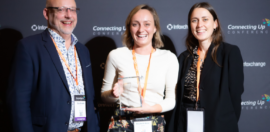What Do the Most Innovative NFPs Have in Common?
25 August 2015 at 12:00 pm
The most innovative Not for Profits share three distinct features, writes Strategy Director of digital consultancy ntegrity, Tony Lee.
If you think innovation means creating groundbreaking, never-before-seen tactics or strategies that make people’s jaws drop, think again.
The crux of all marketing communication is to make customers feel respected and valued – not predict their futures for them. Innovation is not about creating new processes to be followed and it’s not about chasing trends. It’s about clearly communicating what you want to happen next and bringing people along with you on that journey.
It’s therefore best to think of innovation as a mindset, or in some instances, a mind-shift. Because a culture of innovation is one that shares a vision that is so contagious that it is inextricably compelled to create, invent and transform the world around it.
As a digital agency that works closely in the sector, we’ve observed three consistent traits that innovative NFPs share.
1. They experiment.
Innovative charities invest in their employees’ self-belief and ownership. They create an environment where creativity is a valued commodity, learning is incentivised, and testing ideas in live environments is not a luxury – it’s an integral part of the process.
Often this manifests in a good working relationship with technology. Employees are given the freedom to test, measure and learn using up-to-date software, systems, and tools that bring ideas to life.
Armed with these resources, these employees don’t just stop at the dreaming and ideation phase: they push forward into research, execution, refinement, testing, iterating and improving.
There is a culture of “why not?”: an environment where staff are encouraged to try things out even at the risk of making mistakes. This ‘permission to fail’ is a key to all innately innovative cultures where people consistently seek more effective ways to achieve outcomes.

2. They’re community-minded.
Charities like Movember, beyondblue and GetUp! – each of whom were named as one of Australia’s top 10 most innovative NFPs – all place an emphasis on building and maintaining their communities. They invest in treating their supporter base as ongoing advocates for their message and mission, which in turn generates momentum and social proof: when potential donors arrive on their digital channels, they are immediately greeted with a true sense of belonging.
Innovative brands also grant consumers a license to engage with their campaigns and express their loyalty in their own way. By showing that they trust and respect their audience implicitly, innovative brands can extend greater favour and generate support from the community beyond their base.
An essential ingredient is empathy – truly thinking about human needs and desires in order to craft your communications. By placing the user at the center of everything you do, you are ensuring that each interaction with your brand is resonant, intuitive and fluid. For example, beyondblue has successfully engineered campaigns such as Man Therapy and #BrainsAreWeird by understanding the nuances of traditionally difficult to engage target groups.

When Not for Profits prioritise humans, they create meaningful solutions. Does your NFP put people at their core?
3. They exude confidence; both internally and externally.
Confidence comes from clarity of purpose and a strong belief in achieving the right outcomes. When a brand develops confidence, it produces an unstoppable ripple effect that starts from within and echoes out to the community at large.
Internally, confidence is amplified most effectively in non-hierarchical team environments which are naturally more conducive to collaborative communication (both verbal and non-verbal).
The lesson for Not for Profits is that for innovation to break through, a systemic change in the way that teams communicate must be given priority. By breaking down barriers and opening up access and channels to transparent interactions, teams can more readily share in the common ideas that unite them and develop the courage and confidence to embrace new ideas.
Every innovative organisation needs a catalyst. Will you be that next champion for change?
About the author: Tony Lee is Strategy Director of digital consultancy, ntegrity. With over 17 years of marketing experience, Tony thrives on bringing to life branding, social media and content strategies that defy the big-budget dependencies of traditional media. At ntegrity, he leads a stable of NFP clients implementing innovative solutions to improve donor connections online. He can be contacted at tony@ntegrity.com.au







